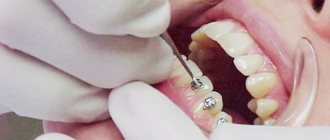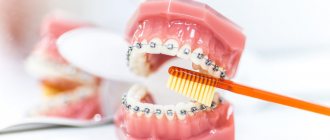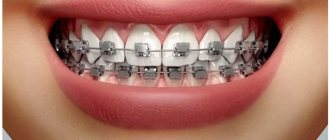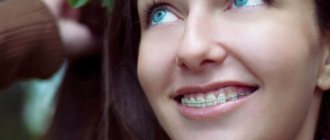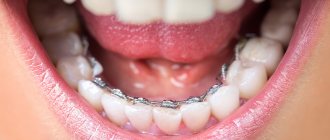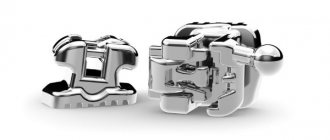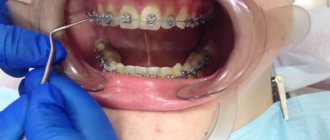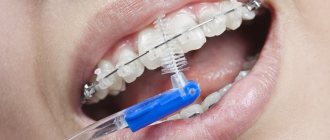303
Ceramic braces are ideal value for money.
In terms of their efficiency, they are somewhat inferior to metal, but, unlike the classic metal system, they are hardly noticeable to others.
What else do patients need to know when choosing between different types of orthodontic appliances?
Detailed overview of the system
A ceramic design is one of the types of vestibular braces. It is attached exclusively to the outside of the teeth; there are no lingual systems made of ceramics.
As in any classical orthodontic system, the ceramic device includes three elements - a plate (locks), a metal arch and fasteners.
For the manufacture of locks , high-quality ceramics are used, characterized by a high level of strength and, as a result, durability.
Depending on the characteristics of natural tooth enamel, monocrystalline ceramics, which is characterized by a matte surface, or polycrystalline material, which has a slight degree of transparency, can be used.
As for the color of the plates, it is also matched to the color of natural enamel.
Recently, it has become popular among patients to install braces several shades lighter than the shade of their teeth.
With this harmless manipulation, a visual whitening effect is achieved without additional procedures.
Installation of ceramic braces
Installing braces is a comfortable and painless procedure that is completed fairly quickly. However, preparation for it may take time, because braces are glued only to absolutely healthy teeth, so in most cases the installation is preceded by sanitation of the oral cavity. When everything is ready, there are only three steps left to go through.
- First, the teeth are treated with a special acid composition, which roughens the enamel and improves adhesion.
- The braces are then bonded to the teeth using a special dental compound. With the direct method, the doctor attaches braces one at a time to each tooth; with the indirect method, he places them on a cast of the patient’s jaw, and then transfers them to a mouthguard, which he puts on the patient, gluing all the locks at the same time. The indirect method is more comfortable for the patient (no need to sit with your mouth open for a long time), while the direct method allows you to position the locks with pinpoint precision.
- A power arc is threaded into the locks and secured with wire, rubber bands or latches if a ligature-free system is installed. Also, if necessary, the device can be supplemented with hooks, pulls and other auxiliary elements.
Design elements
As we have already said, the orthodontic structure consists of three elements. Let's take a closer look at each of them:
- Ceramic plates are the basis of the braces system. They are attached to the outside of the teeth.
As a material for their manufacture, most manufacturers prefer to use aluminum oxide, which has a high level of strength and good aesthetics.The devices can be made of ceramics only or using a combination of materials - ceramics with a metal lock or with a metal groove. Of course, the best aesthetics are observed in all-ceramic structures.
- The metal arch not only connects the plates to each other, but also performs the main function of creating the necessary pressure to move the teeth.
To fasten the arc, locks or special elastic bands (wire) are used. Since the arc is made of metal, it is clearly visible to others. At the request of the patient, it can be coated with a special white composition. - Fastening system. Today, two types of fastening are used in orthodontic structures - using special locks on the surface of the plate itself or using ligatures (metal wire or rubber rings).
Manufacturers
Ceramic braces produced by different manufacturers differ in design features and materials. This affects both comfort and speed of treatment.
Clarity
The products are manufactured by the American company 3M Unitek, which is considered one of the world leaders in the production of orthodontic products. This is an expensive option for braces. There are both ligature and non-ligature models (Clarity SL).
The systems are durable, aesthetically pleasing, and do not need to be painted (even suitable for smokers). Made from fine ceramics with the addition of zirconium dioxide. The material for the clips is plastic nitinol (an alloy of titanium and nickel). The devices are fixed in such a way that tooth enamel is not damaged when removed.
Mystique
They have high strength because the design contains reinforced mesh. For greater aesthetics, the metallized groove is treated with a thin silicate film.
Aspire
Produced in Germany. The braces contain gold, which prevents any allergic reaction. The systems can cope with any load thanks to reliable fastening.
Damon 3
Non-ligature structures with a convenient design are produced by the American company Ormco. They are small in size, so they look quite neat. These are combined systems that combine ceramics, plastic, metal grooves and locks. They provide delicate displacement of teeth, blood circulation in the periodontium is not disturbed. They are worn comfortably and without chafing. A distinctive element of the devices is the presence of patented covers. The latter are designed to hold the arc.
Experience ceramic
Self-ligating systems with low-profile plates and high-quality locks. Each plate provides “wings” for ligatures. The orthodontist has the opportunity to change the passive method of influence to the active one.
In-Ovation
Manufacturer: American-German concern GAC Dentsply. The body of the braces is made of solid ceramic elements, so the designs are durable and reliable. The color of the material is natural, as phosphorus is added to the composition. I cover the anatomical basis of the clasps with several abrasive layers, which ensures faster alignment of the dentition and improved fixation. There are no hooks or ligatures. This means that oral hygiene procedures are much easier to perform. The manufacturer guarantees that the braces will not come off during treatment due to the tight fit of the clasps to the teeth. The price of the products is high due to the unique composition of the material (rhodium and high-quality ceramics) and technical characteristics.
Shine
These are ligature systems that are of good quality and affordable prices (1.5-2 times lower than competitors). Manufacturer: Chinese company Smart. For the manufacture of products, inorganic nanoceramics are used, characterized by a translucent structure and strength. If necessary, the ceramics are supplemented with a metal groove to increase the impact on the teeth and speed up the correction process.
Varieties
Now let's turn our attention directly to the fastening system. It is this element that largely determines the comfort of wearing braces and, oddly enough, the final cost of the entire structure.
This category presents two types of systems - ligature or non-ligature.
Ligature
Ligatures are small rings made of rubber or wire made of medical steel , with the help of which an arc inserted into the grooves is attached to the locks.
Small rubber bands are traditionally used in the early stages of treatment. Depending on the age of the patient and his preferences, the elastic bands can be translucent or colored.
In this case, the color can vary from a light shade to match the ceramic plates to something so bright and rich.
The main disadvantage of elastic bands is that while wearing them, they can stretch and tear, which is why you will have to visit the orthodontist’s office much more often than planned. In addition, light-colored rubber bands may become stained by food coloring.
Wire ligatures are characterized by more reliable fixation. Most often they are used in the middle of treatment or at the final stage. At the same time, patients often complain of discomfort caused by trauma to the oral mucosa with metal elements.
To maintain the required level of pressure on the elements of the dentition during each correction, the ligatures are replaced. This must be done once a month.
Unligated
As the name suggests, this is a self-regulating system in which rubber rings or wires are not used.
Fixation of the arc in this embodiment is carried out using special fasteners located on the surface of the locks.
The main advantage of self-adjusting braces is the absence of monthly corrections. In addition, the plates of non-ligature devices are smaller in size, which provides the system with aesthetics and comfort during the correction of defects.
And although both types of orthodontic structures are equally effective, the cost of non-ligature systems is much higher.
Types of ceramic braces
Which ceramic braces should I use? Before answering this question, you need to understand what types of braces the dentist can offer the patient. Ceramic bracket systems differ in the type of fastening of the power arc.
Ligature braces
This is a classic of orthodontics. A ligature is a fastening element that connects the lock and the power arc: as a rule, it is a miniature rubber band or (less often) a thin wire. During the treatment process, the doctor can change the pressure force of the arc: at first it is fixed with softer rubber bands, but later the orthodontist replaces them with more rigid ligatures, increasing the impact.
Treatment with ligature braces requires constant monitoring and monthly visits to the orthodontist, as the elastic bands stretch over time and require replacement. But the price of ceramic braces with ligatures is quite affordable - this is their main advantage.
Non-ligature braces
A relatively new, high-tech method of correcting a bite.
Ceramic non-ligating systems hold the power arc using a special miniature latch, which is already built into the bracket, which is why they are also called self-ligating. Such systems are more comfortable to wear, since they have a smaller volume, distribute pressure more evenly, and in addition do not require monthly visits to the clinic. However, it is worth considering that prices in Moscow for ceramic braces without ligatures are higher.
Models from famous manufacturers
The use of quality materials is an important component of successful orthodontic treatment.
During the existence of bracket systems, a list of trusted manufacturers has been formed. Let's take a closer look at each orthodontic design.
Clarity
Clarity is a non-ligation bracket system consisting of clasps fixed on plates and a metal arch.
First of all, braces from this manufacturer attract attention with their miniature size, which makes them almost invisible in the patient’s mouth.
In addition, this allows you to avoid diction problems and minimize discomfort during the treatment process.
To produce Clarity braces, polycrystalline ceramics are used , identical in color to tooth enamel.
The material is not affected by food dyes and does not lose its aesthetic characteristics throughout the entire period of wearing the system.
At the same time, in terms of strength and efficiency, Clarity is not inferior to reliable metal structures.
How practical are plastic braces and how to care for the systems.
Come here if you are interested in the design of Damon 3 braces.
At this address https://zubovv.ru/ortodontiya/breketyi/vestibulyarnyie/blesk-neprevzoydennaya-estetika.html you will find detailed information about Blesk braces.
Reflection
Reflection is a ligature bracket system in which special elastic bands are used to attach a metal arch.
For the manufacture of braces, a combined material with the addition of zirconium dioxide is used. This provides the structure with increased strength and reliability.
The grooves are resistant to abrasion, cracking, discoloration or staining. In addition, the Reflection system is based on a special dovetail connection, which allows increasing the area of adhesion of the plate to tooth enamel without loss of aesthetics.
Despite the high quality, aesthetic and functional characteristics, in terms of cost, Reflection braces can easily compete with designs from other manufacturers.
In-ovation
One of the most popular orthodontic systems with excellent aesthetic and functional characteristics.
These are self-regulating devices made of a combined material. Ceramics make the grooves unnoticeable and resistant to food coloring.
And zirconium dioxide provides the structure with strength and resistance to sudden temperature changes.
One of the advantages of the In-ovation system is the movement of teeth in a row without damage to the enamel and periodontal tissue .
Damon
Damon braces are a ligature-free system from an American manufacturer. Today, most dental clinics prefer this brand of braces.
This popularity is due to the ease of wearing and maintenance of the design, high aesthetic characteristics and functionality.
The self-adjusting Damon system reduces the friction force between the locks and the arch , which allows for faster results of orthodontic correction and reduces the duration of wearing the structure.
Sapphire bracket systems
Sapphire braces are considered the most aesthetic among traditional braces; they are made from a transparent crystal grown under artificial conditions - sapphire. Transparent sapphire braces look like a decoration on your teeth; they will not change their color during the treatment process and are attached much more securely than other braces. However, along with the advantages, this system has significant disadvantages:
- sapphire braces are invisible only on snow-white teeth and stand out strongly if the enamel has a yellowish tint;
- the price of transparent braces for teeth made of sapphire is quite high - this is due to the complexity of manufacturing the material and the painstaking installation of the structure;
- This is the most fragile orthodontic system and can crumble when removed, resulting in the need to file it away from the enamel.
Patient pictures
Pros of ceramic braces
Ceramic braces are usually fixed to the outside of the teeth; these are the so-called vestibular models. The most attractive property of such systems is their color, because... light structural elements are almost invisible in the dentition. There are designs of braces with a white arch, when the metal is covered with enamel. Also, the positive qualities of braces made of ceramic material include:
- easy adaptation - addiction occurs very quickly;
- hypoallergenic material;
- individual color selection - the structure is painted in a color close to enamel;
- matte finish, which makes them even more invisible.
Indications and contraindications
Indications for installation of ceramic systems:
- anomalies of bite and individual teeth in a row;
- facial asymmetry or impaired diction caused by malocclusion;
- crowding of teeth or, conversely, the presence of gaps;
- impossibility of installing a classic metal orthodontic system.
The bracket system cannot be installed if there are the following contraindications:
- lack of a large number of teeth in a row;
- the presence of implants in the oral cavity, multiple fillings and restorations;
- severe diseases of various organs;
- the presence of cracks and chips in the enamel;
- diseases of the skeletal system;
- mental disorders.
A relative contraindication to orthodontic treatment may be poor oral hygiene or allergic intolerance to certain materials.
Advantages and disadvantages
Ceramic malocclusion systems have advantages and disadvantages.
Pros:
- Beautiful appearance. You can choose a shade that will be as close as possible to the color of your teeth.
- Durability. Ceramics are resistant to temperature changes and mechanical stress.
- Harmlessness. Even with prolonged use, they do not affect the quality of teeth and do not violate the integrity of the enamel.
- Comfort. The base is made of smooth material. It does not injure the mucous membrane and does not cause discomfort.
- Price. The cost of a ceramic structure is at an average level. Such braces are more expensive than metal ones, but cheaper than sapphire ones.
Minuses:
- With serious changes in the structure of the dentition, they may be ineffective. In this case, metal grooves are installed or the entire system is changed.
- Over time, the cosmetic appearance is lost. With prolonged use, stains appear on the ceramic base or it turns completely yellow.
- Because installing a ceramic system requires training and experience, this service is not available in all healthcare facilities. Some dentists prefer traditional metal structures.
Flaws
Only those patients who have gone through all stages of correction can evaluate the disadvantages of devices.
But the task of the attending physician is to warn the patient about the shortcomings even before installing the chosen design. Among them:
- gum (ligatures) can be colored under the influence of pigments from coffee, tea, berries, wine and other bright foods or drinks;
- longer correction period compared to the classic metal system;
- ceramics are more expensive than structures made of plastic or metal.
Important! In case of complex dental anomalies, comfortable-to-wear ceramic braces may be ineffective. In such situations, it is advisable to use metal systems.
Advantages and disadvantages
The main advantages of ceramic braces:
- Fast adaptation.
- Reasonable prices.
- Productivity. Allows you to eliminate most dental anomalies.
- High aesthetics. Weakly visible up close, almost invisible from afar. If the arc is painted white, the structure will be even less noticeable.
- Hypoallergenic.
- Possibility of repeating the natural shade of tooth enamel.
- Rounded shapes and smooth surface of the plates. Minimal risk of injury to the gums and oral mucosa.
But ceramics also have disadvantages:
- Fragility. The product may break or crumble due to temperature or mechanical effects.
- Long treatment period (compared to metal systems).
- Susceptible to food coloring. However, when using high quality material, staining does not occur.
- Risk of demineralization of tooth enamel (due to the tight fit of the device elements to the teeth).
Ceramic structures do not always allow one to cope with complex clinical cases.
Installation and adaptation
Fixing the system is no different from installing a metal or sapphire structure. Main stages:
- A bracket is attached to each tooth on the outside. For fixation, a special glue is used, which ensures strong adhesion of the artificial material to the surface of the dentition element.
- After this, all the locks are connected with a metal arc , fixed with rubber bands in the ligature system.
- Orthodontic rings and buccal locks to support the arch. Locks can be fixed to tooth enamel or welded to rings.
The installation procedure is absolutely painless, and the most that can bother the patient is discomfort from staying in one position for a long time.
Some discomfort and pain may occur after fixation and persist for the entire period of adaptation to the orthodontic structure.
The main problems that patients may encounter at the initial stage of treatment:
- Pain of varying intensity when clenching teeth or chewing. This is considered a normal reaction to ongoing changes. Typically, pain persists for 1-2 weeks after installation of the system. It can be removed using any painkiller.
- Rubbing the mucous membrane. Like pain, a similar side effect can develop in the first 2 weeks of wearing braces. Special wax will help prevent the formation of ulcers at the site of rubbing.
- Impaired diction. This is a normal reaction to the presence of a foreign body in the oral cavity. At the end of the adaptation period, speech clarity is restored on its own.
Types of modern aesthetic braces systems and an overview of popular designs.
This publication contains photos of Smart Clip braces.
Here https://zubovv.ru/ortodontiya/breketyi/vestibulyarnyie/in-ovation.html we will discuss the pros and cons of In Ovation braces.
What braces are called transparent?
Transparent dental braces include ceramic and sapphire systems. They are the least noticeable on the teeth, but, of course, they cannot be called completely invisible. The design elements will still be noticeable.
In addition to the aesthetic component, when choosing a method for correcting malocclusion and straightening teeth, many other characteristics should be taken into account: is it difficult to install transparent braces, are they comfortable to wear, what are the pros and cons. Orthodontic treatment is quite long, so it should be as comfortable as possible for the patient.
Care instructions
During the correction period, teeth are more at risk of developing caries. Therefore, careful oral hygiene is an integral part of daily care.
It is necessary to brush your teeth after every meal, using a whole arsenal of tools - a special brush, brush, dental floss, irrigator and mouthwash.
Ceramic braces are more fragile than metal braces. Therefore, for the entire period of treatment it is necessary to avoid hard or sticky foods, which can damage the structure.
The ban includes crackers, bagels, chewing gum, toffees, caramels, carrots and other similar products. You should also avoid exposure to food dyes and sudden temperature changes.
Description and characteristics of the systems used
The structures under consideration belong to the group of vestibular (external) orthodontic devices. They consist of 3 main elements, namely:
- Arches are metal products that connect braces by passing through each of the plates.
- Fasteners fixing the above-mentioned parts of the system.
- Ceramic plates installed on the labial (cheek) side of the teeth using special glue.
Braces are made individually for each bone formation and are equipped with special grooves for arches.
Photo: structure of a ceramic bracket system
Classification of ceramic braces
In accordance with the design features, devices are classified into ligature and self-ligating. Ligature-free systems are the latest developments in the field of dentistry; they are attached without the use of tying arches, and are characterized by flexibility and ease of care.
To install non-ligature ceramic braces, clip-on clips are used. During the correction of dental pathologies, the components of the structure move smoothly, affecting the deformed bone formations, expanding the space between them (if necessary). The use of self-ligating devices minimizes the number of traumatic injuries to the oral mucosa.
Ligature ceramic bracket systems are the most common group of orthodontic devices. Their fixation is carried out using tightening elements: rubber bands, metal wire. By holding the plates in the required position, they put pressure on the dentition, align and normalize the bite. The tension force is adjusted by a doctor once a month.
Today, braces with the traditional silver color of the ligatures are among the least popular. Orthodontists are seeing an increase in the popularity of devices with more aesthetically pleasing white arches.
Photo: ceramic braces with white arch
Additional elements may be attached to ceramic braces: rods, elastic chains, springs, rings. Their involvement is due to the peculiarities of anomalies in the geometry of the patients’ dentition.
Advantages and disadvantages
Vestibular ceramic bracket systems have a significant number of advantages over metal and sapphire analogues. Among the advantages of the orthodontic devices under consideration:
- Aesthetic appearance.
- Possibility of choosing a shade that best matches the color of the enamel. The ceramic bracket system is invisible when communicating with the person undergoing treatment.
- Hypoallergenic. Negative reactions of the body upon contact with the materials from which braces are made were detected in less than 0.1% of the total number of patients examined.
Ceramic braces differ from sapphire systems by the lack of glow when sunlight hits the device.
Photo: bite before and after alignment with ceramic braces
Among the disadvantages of the devices:
- Fragility. After installing the product, it is recommended to avoid solid foods: raw vegetables and fruits, nuts, crackers.
- Discoloration with frequent consumption of strong coffee, tea, and natural juices. White arcs are especially susceptible to staining.
The insufficient strength of the ceramics, which prevents strong tightening of the structure, causes an increase in treatment time by an average of 3–4 months.
According to medical statistics, the tight fit of braces to the teeth causes demineralization of the enamel in a number of patients. If left untreated, the process progresses, leading to the destruction of bone formations.
You can reduce the likelihood of most of these problems by regularly undergoing examination by your doctor.
Duration of treatment
Depending on the specific clinical situation, the duration of orthodontic treatment can be 1.5-2 years. But the measures to restore a beautiful smile do not end there.
Once the desired result is achieved, it must be secured. will help the patient with this - special devices that hold teeth in a new position .
These can be silicone trays worn on a schedule, or metal arches attached to the inside of the tooth.
The duration of the retention period is determined individually, and usually amounts to two periods of wearing braces. In some cases, lifelong use of the structure may be required.
In the video, a specialist talks about the advantages and disadvantages of ceramic braces.
Features of care
After installing ceramic braces, the patient will have to pay special attention to the issue of hygiene. Brushing teeth with an orthodontic design is performed not only in the morning and evening, but also after each meal. This reduces the risk of plaque and tartar forming around each attachment.
- To clean your teeth, use a special brush with a depression in the middle. It allows you to thoroughly clean your teeth and clean hard-to-reach areas of braces.
- After standard hygiene procedures, the patient needs to use a brush and walk through hard-to-reach places under the arch.
- To complete the brushing, use dental floss and mouthwash.
Regular hygiene avoids staining of braces. Any food contains natural or artificial dyes, which over time affect the cosmetic properties of the system. If the patient smokes a lot, drinks coffee and black tea, prefers red wine to white, likes seasonings such as curry, then a change in the color of the braces cannot be avoided. Since you will have to wear the orthodontic system for at least six months, you must try to maintain its original appearance. After installation, you should discuss with your dentist which hygiene products are best to use.
Prices
For convenience, prices for installing popular brace systems are shown in the table.
| Model | Average cost (per 1 jaw) |
| Reflections | 40,000–45,000 rubles |
| Aspire | from 55,000 rubles |
| Clarity | 40,000–45,000 rubles |
| In-ovation | 45,000–50,000 rubles |
| Damon | 80,000 rubles |
Comparison of different systems
To understand which braces are better and how they differ, let's look at the following table.
| Types of braces systems: | Ceramic | Sapphire | Metal |
| Anomaly complexity | The aesthetic system copes with minor anomalies. | The aesthetic system copes with minor anomalies. | Coping with any anomalies. |
| Duration of treatment | Longer in terms of teeth straightening, 2-3 months longer to wear than metal ones. | The treatment period is not inferior to metal ones. | Fast in treatment due to a firmly controlled arc. |
| Aesthetics | Ceramics are matched to the color of the enamel. | Transparent, white-coated arcs, almost invisible when smiling and talking. | Not aesthetically pleasing, clearly visible on the teeth. |
| Price | Average in cost. | The most expensive. | Available for all patients. |
Reviews
What ceramic braces have you used to correct your bite? Leave feedback on your results in the comments.
If you find an error, please select a piece of text and press Ctrl+Enter.
Tags: braces vestibular braces ceramic braces
Did you like the article? stay tuned
Types of orthodontic structures
Dental clinics offer different orthodontic designs. All bracket systems have the same effectiveness, and the duration of their use depends only on the nature of the dental pathology. The designs differ in their method of operation and cost. Ceramic bracket systems are divided into ligature and self-ligating.
Ligature
Ceramic ligature braces are the basis of aesthetic dentistry. This system consists of braces that are connected to each other by special arches, and their tension is regulated by rubber bands or wires. They are necessary to create the correct arc pressure in the pathological area.
In magazines you can see photos of ceramic braces, which are surrounded by a colored stripe. These are rubber ligatures. They need to be replaced regularly - at least once a month. The variety of color palette allows the patient to choose a new shade each time. This is especially popular with teenagers who don't want to wear iron braces.
Unligated
Ceramic non-ligating braces are also called self-ligating braces. In life they look more massive due to the thickness of the arc, but they have advantages.
Corrective systems without ligatures do not require frequent visits to the dentist, and the visit itself is much faster. The patient does not need to change ligatures at each consultation. Using fastening clips, the doctor quickly removes the arch and inserts a new one.
On a note!
The installation and use of self-ligating braces requires additional training. Therefore, many dental clinics are moving away from this method. The use of ligature systems is more effective and does not require medical institutions to spend on training specialists.
Combined braces
Modern braces differ not only in technological features, but also in the material used. In addition to metal models, locks in systems are ceramic, sapphire, and plastic. This variety makes it possible to choose a correction option according to the patient’s preferences and financial capabilities.
Combined braces are a prefabricated orthodontic device in which the clasps are made of different materials. The most popular solution is when more aesthetic options, ceramic or sapphire braces, are installed in the smile area, and metal ones in the chewing teeth area. Photos of combined metal+ceramics or metal+sapphire braces allow us to conclude their obvious aesthetic superiority compared to systems consisting only of metal. At the same time, orthodontists note their high functional indicators.
Speaking about combined orthodontic treatment, some experts also include in this category corrections carried out by fixing systems made of different materials to the upper and lower jaws. Using this approach, aesthetic braces are installed on the upper jaw, and metal systems are installed on the lower jaw.
An orthodontist will advise
which braces to choose To obtain the desired result, not only the patient’s wishes must be taken into account, but also objective indicators and individual characteristics.
Types of combinations of bracket systems
In the vast majority of cases, combined systems consist of metal braces (on chewing teeth) and more aesthetic non-metal structures (ceramic, sapphire).
Combined ceramic braces
Combined metal and ceramic braces are considered one of the most common. Experts advise not to put too much stress on ceramic products, so its use in the anterior part of the upper jaw is very justified. At the same time, metal braces correct the rest of the dentition.
Combined bracket system
Damon.
Ormco offers a good selection of orthodontic structures, including combined ones. This manufacturer has a non-ligature Damon 3 system, consisting of metal and ceramic in a ratio of 40% to 60%. The most commonly used combination bracket system is Damon Clear (made of solid ceramics) in combination with metal Damon Q.
Combined sapphire braces
The combination of metal and sapphire is successful in terms of aesthetics and comfort. In addition, a combination of sapphire and ceramic is possible, which is even more beneficial from a beauty point of view. The only drawback is the high cost, even taking into account the use of metal locks.
Vestibular and lingual systems are also combined due to the high cost of the latter. Invisible braces are placed on the inner part of the dentition of the upper jaw, and any other braces (most often metal) are placed on the lower jaw. It is the upper teeth that are most visible when smiling, so hiding braces from others works quite well.
